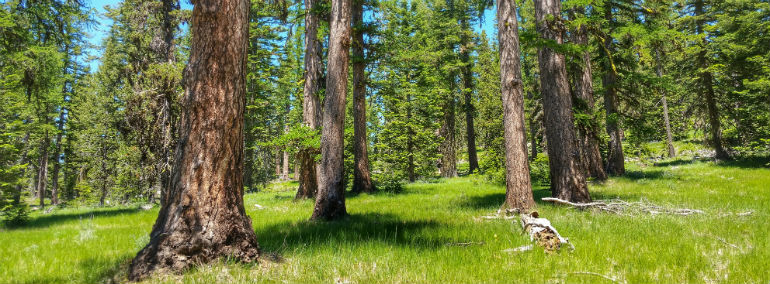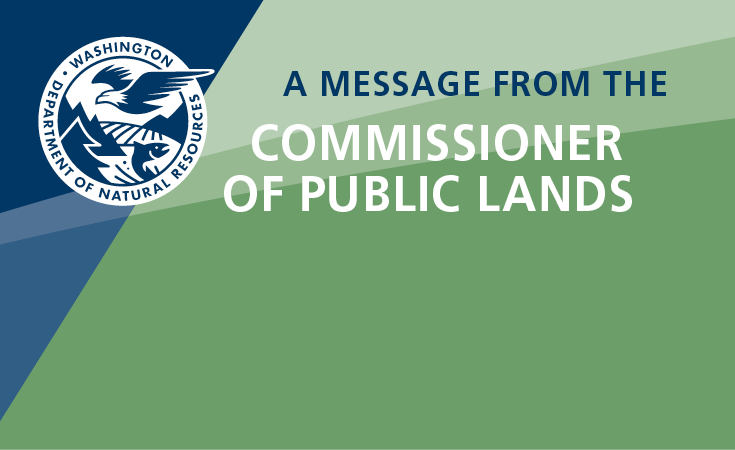
Ecosystems of Washington
Washington Natural Heritage Program (WNHP) ecologists identify the ecosystem types that occur in Washington, assess their distribution, ecological condition, and threats, and then synthesize that information to identify which specific ecosystem occurrences (i.e. sites) are priorities for conservation.
Information about the rarity or potential risk of elimination or extirpation of specific ecosystem types and occurrences help prioritize and guide conservation and/or management actions toward those ecosystems that are of most concern. Since the early 1980s, the NatureServe/Natural Heritage Network has conducted conservation assessments of species and ecosystems to help prioritize conservation actions. The outcome of those assessments is a conservation status rank, which indicates the rarity and risk of elimination of ecosystems and an element occurrence rank, which indicates the current ecological integrity of a specific example of that ecosystem. Together, these two pieces of information allow WNHP ecologists to prioritize specific examples of where conservation action is a priority. This information is used to help identify sites to include within the statewide system of Natural Areas, assist land trusts in making conservation decisions, and inform land use planning and regulatory review by local, state, and federal agencies.
Classification & Conservation Status Ranking
Ecosystem classification is used to summarize complex ecological patterns using a limited number of units. Classification provides a framework for systematic and transparent communication about ecological diversity. The term ‘ecosystem’ does not have a fixed scale in its general usage. It has been used to characterize areas that vary in size from an individual stand of trees to large landscapes. In part because of this, and in order to better understand the diversity of ecosystems, ecologists have developed various ecosystem classification systems to address specific needs and objectives. Consequently, the specific factors used to develop a classification scheme will vary according to the desired uses of the classification.
One of the primary objectives for WNHP ecologists is to maintain a classification and inventory of Washington’s natural heritage resources and prioritize them for conservation action. Classification results in a reasonably definitive list of ecosystem types, and a common language to refer to those types, which then allows the setting of priorities necessary for conservation planning. WNHP uses several classification systems. Fortunately, the different classification systems largely correspond to different physical environments.
A Marine and estuarine classification was developed by Dr. Megan Dethier in 1990. This classification defines ecosystems based on depth, substrate, wave energy and the plant and animal species associated with the combination of habitat variables. The vegetated estuarine components of this classification have been replaced by the U.S. National Vegetation Classification.
Freshwater ecosystems that are too deep for plant growth have not been systematically classified in the state. However, WNHP uses a list of types that were developed in the 1980’s for identifying Natural Heritage Plan priorities.
For wetland and terrestrial ecosystems, two primary ecological classification schemes are used by WNHP including the U.S. National Vegetation Classification (USNVC) and Ecological Systems Classification. The Ecological Systems classification has been used primarily for large-scale conservation planning and as a means to communicate the regional diversity of ecosystems. The USNVC has been used as the primary measure of ecological diversity in the State. USNVC units have historically been the focus of WNHP’s conservation prioritization efforts. However, both classifications schemes offer a complementary approach for describing Washington’s ecological diversity.
Once a list of ecosystem types has been developed, their rarity or extirpation risk is assessed by applying NatureServe’s Conservation Status ranking methodology.
Ecosystem Inventory and Assessment
Ecosystem inventory occurs primarily through field-based efforts but can also happen through ecosystem modeling or mapping efforts. WNHP ecologists are routinely conducting field-based surveys for examples of rare or high-quality common ecosystems. Inventory priorities are determined either through specific project objectives or by identifying data gaps associated with particular ecosystem types.
Understanding ecosystem condition or ecological integrity helps guide management and conservation of Washington’s ecosystems. Ecological condition data can be used for monitoring of status and trends of ecosystem condition, to prioritize sites for conservation or restoration action, and to guide land use planning and regulatory. During field-based inventories, WNHP ecologists collect ecological condition data to help determine site-based conservation priorities. In addition, data describing ecosystem condition are also used to help track restoration and management actions on Natural Areas.
There are a number of ways to approach assessing ecosystem condition, including a focus on ecological integrity. For over thirty years, NatureServe has advanced approaches for documenting the ecological integrity of individual observations or occurrences of ecosystems. Earlier methods relied on fairly qualitative, expert-driven protocols. More recently, the NatureServe methodology has been revised and now uses specific indicators to assess the ecological integrity of aquatic and terrestrial ecosystems. This method, called the Ecological Integrity Assessment (EIA), is a rapid, standardized tool for comparing ecosystem condition across the landscape. WNHP ecologists have tailored the EIA methods for most of Washington’s ecosystem types.
Another approach to assessing ecosystem condition often used by WNHP is the Floristic Quality Assessment (FQA). FQA provides a unique approach to ecological monitoring and assessment which moves beyond simple measures of species richness and abundance and provides an estimate of the quality of native plants at a site. WNHP ecologist sometimes use FQA as a standalone tool and other times as metric within the EIA.
Conservation Priorities
Ecosystem element occurrences are prioritized for inclusion in our Natural Heritage Information System based on a combination of the ecosystem element’s conservation status rank (see our Methods page) and the occurrence’s element occurrence rank as determined by the Ecological Integrity Assessment. A decision matrix (below) is then used to determine whether a site-specific occurrence of an ecosystem qualifies as an element occurrence. Basically, all occurrences of rare ecosystem types, regardless of their condition, are considered element occurrences, while more common ecosystem types must be in good to excellent condition to receive consideration as element occurrences.

Reports
A list of technical reports by Natural Heritage Program ecologists can be found here.


